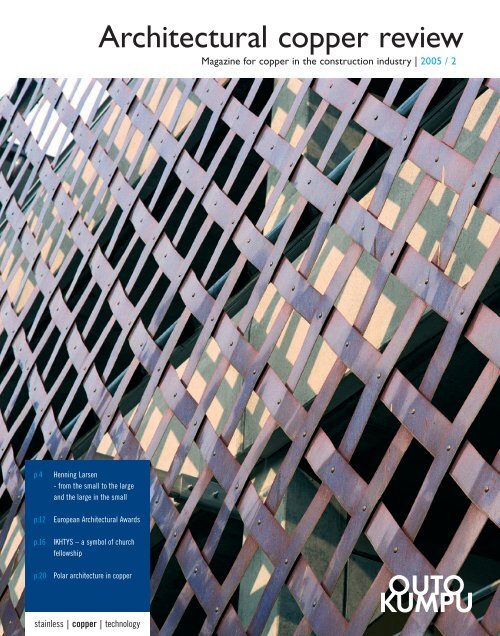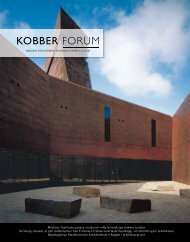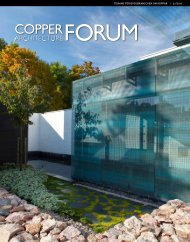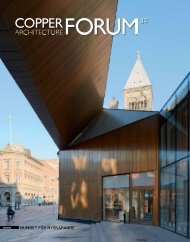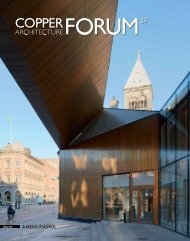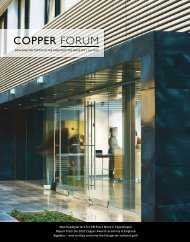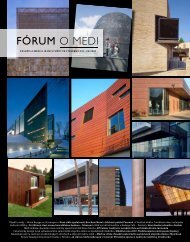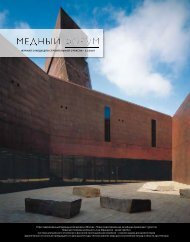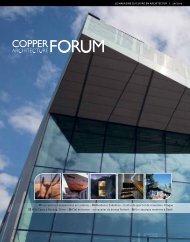Henning Larsen - Copper Concept
Henning Larsen - Copper Concept
Henning Larsen - Copper Concept
Create successful ePaper yourself
Turn your PDF publications into a flip-book with our unique Google optimized e-Paper software.
p.4 <strong>Henning</strong><br />
10<br />
<strong>Larsen</strong><br />
- from the small to the large<br />
and the large in the small<br />
-vuotisjuhla<br />
p.12 European Architectural Awards<br />
p.16 IKHTYS – a symbol of church<br />
fellowship<br />
p.20 Polar architecture in copper<br />
stainless | copper | technology<br />
Architectural copper review<br />
Magazine for copper in the construction industry | 2005 / 2<br />
Kuparia Karibialla .... sivu 6<br />
Grönlannin korkein talo .... sivu 10<br />
Norjan kansalliskirjaston lisärakennus .... sivu 12<br />
Niels Torp: Miten arkkitehti ajattelee? .... sivu 14<br />
Toimistorakennus Helsingissä .... sivu 27
Architectural <strong>Copper</strong> Review | 2005 / 2<br />
Architectural <strong>Copper</strong> Review December 2005<br />
Architectural <strong>Copper</strong> Review is published twice a<br />
year and has a circulation of 1,000 copies. Publisher is<br />
Outokumpu. The magazine is distributed to architects<br />
and professionals in the building construction industry<br />
in Europe.<br />
Editor:<br />
Lennart Engström tfn: +46-21-19 82 54 fax: +46-21-<br />
19 87 04 lennart.engstrom@outokumpu.com<br />
Address: Outokumpu <strong>Copper</strong> Products,<br />
Metallverksgatan 5, 721 09 Västerås, Sweden.<br />
2<br />
Creativity and copper<br />
Architectural creativity with copper, as a starting-point and seen in an<br />
international perspective is the focus of this issue of Architectural<br />
<strong>Copper</strong> Review. I am happy to see that copper is among the materials<br />
that inspire architects’ creativity. We are naturally also very pleased to<br />
be able to present the topic from different viewpoints in this magazine.<br />
One of the latest initiatives is <strong>Copper</strong> in Architecture Awards, where<br />
today not only Great Britain but also most of the European countries<br />
participate with inspiring entries. This has brought variation and<br />
breadth to the projects. I feel that the winning projects, as well as<br />
other prize-winning entries, show significant and promising creativity.<br />
Our interview with great Danish architect <strong>Henning</strong> <strong>Larsen</strong> shows that creativity has nothing to<br />
do with age. Impressively, he is bursting with ideas, even though he has passed 80. It is interesting<br />
in this context that <strong>Henning</strong> <strong>Larsen</strong>, like many other great names within architecture, has a<br />
special fondness for copper.<br />
We are very happy that a great name as Henrik <strong>Larsen</strong> agreed to an interview. Incidentally, I<br />
often find that architects are pleased with the exposure their projects get in our magazine.<br />
Do you have projects you would like us to know about? Please contact me or someone else on<br />
the editorial board. We are looking forward to hearing from you!<br />
I wish you pleasant reading.<br />
Lennart Engström, Editor<br />
Editorial staff:<br />
Mogens Præstegaard Denmark tel: +45 4323 7700 mogens.prastegaard@tibnor.se<br />
Dennis Wraamann Denmark tel: +45 3956 5056 dw@danske-ideselskab.dk<br />
Jan Erik Holler Norway tel: +47 6755 4620 jan.erik.holler@outokumpu.com<br />
Håkan Svedman Sweden tel: +46-21-19 82 50 hakan.svedman@outokumpu.com<br />
Mervi Tähtinen Finland tel: +358 2626 6612 mervi.tahtinen@outokumpu.com<br />
Publisher:<br />
Lennart Engström, Outokumpu.<br />
Layout and technical production:<br />
www.danske-ideselskab.dk, tel: +45 3956 5056
South Street 70 – parking garage with copper<br />
The parking garage on South Street (Södra Vägen) in Gothenburg is<br />
situated in a row of well-known buildings such as Universeum and World<br />
Cultural Museum, right by the southern entrance of the big amusement<br />
park Liseberg. The closest neighbour is a block of flats in functionalistic<br />
style.<br />
The site was earlier occupied by an<br />
older block of flats that burned and was<br />
subsequently demolished. The parking<br />
garage was built partly into the rock as a<br />
subterranean building. The joists are<br />
leaning and you drive up in a spiral<br />
movement. The garage has four and a<br />
half levels and room for approximately<br />
300 cars.<br />
The garage is built in concrete. Pillars,<br />
walls and banister components are pre-<br />
fabricated and the joists are cast in<br />
plastic.<br />
For the facade we were looking for a<br />
material that would give an open grid<br />
facade. Very soon, copper came to our<br />
mind. <strong>Copper</strong> is especially suitable in<br />
this context as it with time becomes<br />
greenish-brown and blends in with the<br />
Liseberg landscape. Furthermore, sev-<br />
eral buildings on Liseberg have by tradi-<br />
tion copper-green roofs, maybe a mem-<br />
ory from the World Exhibition of 1923<br />
in Gothenburg.<br />
The facade is built as a trellis that forms<br />
a transparent wall. The wall is meant to<br />
have a ”woven-textile” look where the<br />
character of the copper is important<br />
both from the outside and from the<br />
inside.<br />
The copper strips are made from one-<br />
millimetre-thick copper sheeting and are<br />
125mm wide. They are attached to a<br />
frame of thick stainless steel pipes. In<br />
each crossing point there is a bolt, and a<br />
washer in between to create more<br />
depth in the facade. The open area of<br />
the netting is 44 percent.<br />
The base is made in gabions, wire net-<br />
Architectural <strong>Copper</strong> Review | 2005 / 2<br />
By Fritz Olausson, Lund & Valentin Architects<br />
ting filled with the same type of granite<br />
as the existing bedrock. Around the<br />
building there is light limestone, to<br />
visually anchor the building to the<br />
ground and to bind copper ions from<br />
rainwater to the limestone.<br />
The staff members at Lund & Valentin<br />
who have worked on the project are<br />
architects Fritz Olausson, Bo Karlberg<br />
and Görel Abrahamsson and building<br />
engineers Rolf Johannesson and Hans<br />
Solborg,<br />
Building proprietor:<br />
Gothenburg City Parking AB<br />
Architect: Lund & Valentin Architects<br />
Construction: Spännbalkskonsult<br />
Electrical work: Probeko AB<br />
Site work: Viproj AB<br />
Water/ventilation/sanitation:<br />
Bengt Dahlgren AB<br />
Contractor: Skanska Sverige AB<br />
Contractor copper facades:<br />
Hisingstads Bleck och Plåtslageri AB<br />
3
Architectural <strong>Copper</strong> Review | 2005 / 2<br />
Henrik <strong>Larsen</strong>’s famous door handle – Sewer lid in cast iron adorned with water drops – <strong>Copper</strong> lamp designed for the opera house<br />
<strong>Henning</strong> <strong>Larsen</strong> – from the small to<br />
<strong>Henning</strong> <strong>Larsen</strong>, 80 years old – world renowned Danish architect whose<br />
mind wanders from the small to the large, and the large in the small,<br />
from detail to entirety. He is master of creating, from a sketch, everything<br />
from door handles, chairs, furnishings and buildings to master<br />
plans, the latest one an overall plan for the town Dalian in northern<br />
China.<br />
The independent artist, such as the<br />
painter or the sculptor, has nothing else<br />
to consider than the material he or she<br />
is working with. The architect is a<br />
craftsman, with the difficult task to take<br />
into consideration all human functions,<br />
materials, techniques and social condi-<br />
tions.<br />
<strong>Henning</strong> <strong>Larsen</strong> is a dreamer, a creative<br />
visionary who thinks in practical terms<br />
and knows how to materialize an idea.<br />
He is an architect who has had the<br />
possibility to realize the most prestig-<br />
ious projects, sometimes with setbacks.<br />
But how does he think when he creates?<br />
I am on my way to visit <strong>Larsen</strong> in<br />
Copenhagen. I find the address,<br />
Vesterbrogade 76 and <strong>Henning</strong> <strong>Larsen</strong>s<br />
Tegnestue. The office is on the two top<br />
stories of an eight-story building. The<br />
receptionist announces my visit. <strong>Larsen</strong><br />
has his work station, “<strong>Henning</strong>’s<br />
4<br />
Corner”, at one end of the large open-<br />
plan office. He greets me with a big<br />
smile; it has been 45 years since we last<br />
saw each other in Stockholm.<br />
It’s been a long time, we say simultane-<br />
ously. We are both marked by the<br />
passing years.<br />
A lot has happened since that time in<br />
1961, when <strong>Larsen</strong> won first prize in a<br />
Nordic architect contest for the new<br />
university building in Stockholm. We sit<br />
down and I show him a photo I took at<br />
the competition. He studies it for a long<br />
time and laughs.<br />
Do you remember that time? – Yes, I<br />
remember it like it was yesterday – from<br />
the joy over the first prize and the<br />
celebration, to the disappointment. I will<br />
never forget it.<br />
Cheated on the commission<br />
<strong>Henning</strong> <strong>Larsen</strong> was granted first prize<br />
for the very special architecture with an<br />
Text og photo: Alf Folmer<br />
Architect: SAR/MAA, Sweden<br />
mail: alf@mbox316.swipnet.se<br />
entirely new and fresh approach to the<br />
university environment in human scale, a<br />
university for 10,000 students. All<br />
buildings were placed on a large, floating<br />
concrete deck that was shaped for the<br />
landscape. Below the deck there was<br />
parking space for 3,000 cars. Young<br />
<strong>Larsen</strong> was at the time unknown as an<br />
architect.<br />
What were you thinking, when you were<br />
awarded such an honourable prize?<br />
– I was in Denmark at the time and<br />
couldn’t believe it at first! I was sum-<br />
moned to Stockholm to receive the<br />
prize. Then the cold shower and the<br />
disappointment.<br />
The politicians’ viewpoint was that a<br />
Swedish university should be designed<br />
by a Swedish architect. So I was in fact<br />
cheated on the commission, which<br />
instead was given to the second-prize<br />
winner, the well-known Swedish archi-<br />
tect David Heldén, who had designed
Cafeteria chair in steel – The opera house in Copenhagen – General plan for Dalian in China.<br />
Architectural <strong>Copper</strong> Review | 2005 / 2<br />
the large and the large in the small<br />
the high-rise buildings in the new<br />
Stockholm City.<br />
This caused a big disappointment and a<br />
great stir in Swedish and Danish newspa-<br />
pers and the entire architectural profes-<br />
sion. What was your opinion of the<br />
Swedes after this? – It was not fair play,<br />
<strong>Larsen</strong> says gloomily. I was angry. The<br />
politicians were totally blind for good<br />
architecture. Giving the assignment to a<br />
Swedish architect became more impor-<br />
tant than getting good architecture. But<br />
this is not how it works today.<br />
David Heldén’s second prize entry was<br />
an ordinary proposal with six eight-floor<br />
buildings, all with the same pre-fabri-<br />
cated building technique as the high-rise<br />
buildings in Stockholm City, the facades<br />
pale green, cool and sterile. Today they<br />
stand there as a disgrace.<br />
However, <strong>Larsen</strong>’s proposition received<br />
international attention. It became his<br />
great break-through and the beginning of<br />
an international career. Ten years later<br />
<strong>Larsen</strong>’s university proposal was carried<br />
out in Trondheim, Norway. He was at<br />
that time an established and well-known<br />
architect with a large office in<br />
Copenhagen.<br />
Amputated tower<br />
In 1989, <strong>Larsen</strong> won the competition of<br />
Söders Tower in Stockholm. The pro-<br />
posal was a 40-story office building.<br />
Then the politicians started to meddle in<br />
the architecture.<br />
They thought that Söder’s ”campanile”<br />
competed with the famous city hall<br />
building across the city, designed by<br />
Swedish national architect Ragnar<br />
Östberg.<br />
This started a fight over the height and<br />
architecture of the building. The plans<br />
were revised and trimmed several times.<br />
New contractors were hired and this<br />
started discussions about building meth-<br />
ods. <strong>Larsen</strong>’s strong tower architecture<br />
was trimmed down to 23 floors and<br />
changed to a block of flats. It was like<br />
letting the air out of good architecture.<br />
Another setback in Sweden, how do you<br />
deal with it? – Everybody wants to get<br />
involved in the architecture. I am embit-<br />
tered by the market in Sweden being<br />
totally run by entrepreneurs and politi-<br />
cians. We had conflicts from the very<br />
beginning. The biggest problem was JM<br />
BYGG, who started to change details<br />
and materials without permission. I had<br />
strived for using thoroughly worked-out<br />
materials and details, and I got very<br />
upset. Today, Söders Tower stands as an<br />
unfinished piece of architecture. I don’t<br />
wish to have my name on it. I am very<br />
disappointed but not unforgiving, says<br />
<strong>Larsen</strong>.<br />
<strong>Copper</strong> architecture<br />
The Swedish bureaucracy is so tough<br />
that for instance when an architect<br />
selects copper as roof material there is<br />
great resistance from the authorities.<br />
They believe that copper is harmful to<br />
the environment, although there is proof<br />
that copper ions from rainwater are<br />
bound in the ground and never enter the<br />
groundwater. <strong>Copper</strong> is nature’s own<br />
building block and even necessary for<br />
human life.<br />
Have you met problems with using<br />
copper in other countries? – I have<br />
never had any problems. Nobody ob-<br />
jects if we want to use copper in<br />
Denmark, everyone likes it, says <strong>Larsen</strong>.<br />
He shows some pictures of his copper<br />
architecture. – This is Mekoprint, two<br />
factories in Stövring, Denmark. It is an<br />
international project that I decided to<br />
cover entirely with copper and a large<br />
glass facade. Mekoprint’s copper archi-<br />
5
Architectural <strong>Copper</strong> Review | 2005 / 2<br />
The copper-clad Unibank headquarters blends in nicely with Copenhagen’s historical milieu.<br />
<strong>Henning</strong> <strong>Larsen</strong> in 1961. He had recently won first prize<br />
in a Scandinavian architect contest for Stockholm<br />
University. He was very happy – for a short while.<br />
tecture is now a prominent landmark in<br />
the Northern Jutland town of Stövring.<br />
The attractive building in a warm cop-<br />
per-brown has won architectural con-<br />
tests.<br />
– But the best of my copper architec-<br />
ture is probably Unibank’s new head-<br />
quarters in the centre of Copenhagen. I<br />
have achieved a nice interplay between<br />
the copper and the old environment.<br />
Also this project has won awards for its<br />
convincing architecture that respectfully<br />
blends in with the historical neighbour-<br />
hood. The building is known for enrich-<br />
ing the urban landscape along<br />
Copenhagen’s harbour.<br />
– <strong>Copper</strong> is a classical and timeless<br />
material. We have new projects in the<br />
making and nobody will stop us from<br />
using copper, says <strong>Larsen</strong> firmly.<br />
6<br />
The Music Building in Uppsala<br />
We take a tour of the large office. In<br />
the model department four people are<br />
working on large-scale models of on-<br />
going projects. There are models high<br />
and low.<br />
What use do you have of the models? –<br />
A drawing is two-dimensional. To study<br />
the models allows us to experience a<br />
three-dimensional project. We also use<br />
computers to create visual perspective.<br />
We move on to the conference room.<br />
One wall is covered by a blackboard<br />
filled with rough sketches, visualized<br />
ideas from a meeting. <strong>Larsen</strong> wipes<br />
away some of the sketches from the<br />
board and quickly draws a new one. I<br />
can see that it depicts an Uppsala<br />
silhouette.<br />
Model of proposal to Unibank’s headquarters in Copenhagen. Half of the block has<br />
copper cladding.<br />
You are making a sketch of Uppsala,<br />
what is happening there? -Yes, you are<br />
right, it is Uppsala. We are finally on<br />
the way there, but again with some<br />
setbacks. We won first prize with a<br />
proposition for a concert- and congress<br />
building, an enormous project. I wanted<br />
to create a crystal in the middle of old<br />
Uppsala. The proposal is a building with<br />
reflecting facades that make it light and<br />
airy in the urban landscape. From the<br />
inside you get a magnificent panoramic<br />
view of the castle, cathedral and library.<br />
This is what I sketched on the board.<br />
But when the proposal became public<br />
the objections started, from the politi-<br />
cians and from the general public.<br />
Uppsala New Post wrote, ”At first I<br />
thought it was a picture of the ice hotel<br />
in Norrland. God help us! A 30-meter<br />
tall glass colossus – have the judges no
feeling for Uppsala?” People were<br />
upset and protested. Many thought<br />
that the proposal was an insult to<br />
Uppsala’s beautiful old milieu.<br />
Advocates of the project fought to<br />
carry it through. With a few small<br />
changes it will be built. The ground-<br />
breaking was solemnly done. The<br />
building is underway and is estimated<br />
to be completed in 2007.<br />
Opera house as a memorial<br />
of a family<br />
During our conversation <strong>Larsen</strong> be-<br />
comes enthusiastic. He starts telling me<br />
about his latest project, the one that<br />
almost ended in disaster: The<br />
<strong>Henning</strong> <strong>Larsen</strong> 2005 in his office in Copenhagen, now a world-renowned architect. He would like to tie<br />
up in bundles those who meddles in his architecture and put them back where they belong.<br />
Copenhagen Opera House, the largest<br />
opera house in Scandinavia. An enor-<br />
mous building that cost almost three<br />
billion crowns to build. Officially, the<br />
opera house is a gift to the city from<br />
ship-owner, grand old man Mærsk<br />
McKinnney Møller, Denmark’s most<br />
powerful capitalist, but Møller’s real<br />
motive is for the opera to primarily be a<br />
memorial of the giver and his family,<br />
especially his parents. Møller bought a<br />
closed military area on the island<br />
Holmen for several million crowns. This<br />
is where he wanted the opera house, in<br />
line with the royal castle Amalienborg<br />
that is situated on the other side of the<br />
bay; the castle on one side and the<br />
memorial on the other. The ship-owner<br />
decided that the architect had to be the<br />
most prominent in Denmark, <strong>Henning</strong><br />
<strong>Larsen</strong>.<br />
This is a fantastic project. It must be one<br />
of the best you ever created?<br />
Architectural <strong>Copper</strong> Review | 2005 / 2<br />
– Certainly not! Already in the beginning<br />
the ship-owner meddled in the architec-<br />
ture, from the material selection to the<br />
facade design. For example, I wanted the<br />
most important facade of the opera<br />
house to be entirely in glass with an<br />
open view of the harbour and the city.<br />
My vision was for the large roof to look<br />
like it was floating on a large glass bub-<br />
ble, a fantastic contribution to architec-<br />
ture. Then Møller decided he didn’t like<br />
the glass facade. He feared that the<br />
visitors to the opera would feel like they<br />
were in a fishbowl. Instead he insisted<br />
on a solid facade. As a compromise,<br />
heavy strips of steel would be used to<br />
cover the glass and screen the pano-<br />
ramic view.<br />
To <strong>Larsen</strong> this was to give up on what<br />
he felt was the most important architec-<br />
7
Architectural <strong>Copper</strong> Review | 2005 / 2<br />
tural feature of the opera house.<br />
But you didn’t resign from the opera<br />
project? – The contract with Møller<br />
bound me hand to foot, I could not get<br />
out. The contract states specifically that<br />
the commissioner makes the decisions.<br />
Møller threatened to sue, which would<br />
have ruined me and put my staff of more<br />
than one hundred people out of work.<br />
Møller is a ship-owner and knows a lot<br />
about ships and finances, but nothing<br />
about architecture, <strong>Larsen</strong> says bitterly.<br />
The much fought-over building is now<br />
completed and inaugurated. The news-<br />
paper Berlinske Tidene raves about the<br />
opera house, however mostly over the<br />
inside, while Politiken calls it ”a hunch-<br />
backed creation. The overall design is a<br />
patchwork without originality”. In the<br />
urban landscape the building is intrusive,<br />
an over dimensioned block. The pre-<br />
dominate glass facade with its steel<br />
8<br />
strips is nicknamed ”the Grille” and ”the<br />
Toaster”. In spite of this, the opera has<br />
been awarded several prizes for its<br />
architecture. – I’m hoping to some time<br />
in the future be able to remove the<br />
disgraceful steel strips on the glass<br />
facade. I will not be satisfied until that<br />
happens, says <strong>Larsen</strong>.<br />
Hired a lawyer<br />
Wise from bad experiences with med-<br />
dling commissioners, entrepreneurs and<br />
politicians, <strong>Henning</strong> <strong>Larsen</strong>s Tegnestue<br />
has now hired a lawyer in order to<br />
create contracts and agreements based<br />
on the architect’s terms. Entrepreneur,<br />
commissioner and architect always<br />
work closely together and there is<br />
always a risk for conflicts. It is impor-<br />
tant to solve problems right away,<br />
before they get out of hand.<br />
Mekoprint, Støvring, Denmark<br />
Söders Tower viewed from the park. The winning proposal for Söders Tower in Stockholm, 40<br />
floors, 140 meters tall. (Turning Torso in Malmö is 190 meters tall and has 54 floors.) The Tower<br />
was reduced to 23 floors.<br />
Have you seen results of this? – We<br />
Plan for the Stockholm University proposal<br />
have more international projects today,<br />
and the contract is then extremely<br />
important. We have already noticed the<br />
benefits with having our own lawyer. As<br />
an architect you are a creative visionary,<br />
often with your head up in the blue. The<br />
lawyer stands firmly with both feet on<br />
the ground and makes sure that we<br />
avoid serious conflict of interest.<br />
When <strong>Larsen</strong> creates<br />
To sketch is typical for <strong>Larsen</strong>. The<br />
blackboard is full of sketches. They are<br />
his tools in the creation process.<br />
How does your mind work and where<br />
do you get your ideas? – My upbringing<br />
has shaped my life and the way I think. I<br />
learned practical thinking while being<br />
apprentice to a carpenter and getting my<br />
diploma, and theoretical thinking in my<br />
architectural studies. Also my religious<br />
upbringing has shaped me. My father
The concert- and congress building in Uppsala will shine like a<br />
crystal in the urban landscape.<br />
Model of the university proposal,<br />
see also the plan above.<br />
sang in the church choir and I loved to<br />
sit in the church and listen to the music.<br />
I discovered that church music and the<br />
church building belong together. The<br />
music by Bach is architectural music.<br />
When listening to Bach I hear and see<br />
architecture.<br />
You are known to sketch a lot. – When I<br />
sketch I experience music, rhythm and<br />
shape. It is like playing a musical score of<br />
sense impressions that in turn become<br />
visions, which become sketches and<br />
later materialize into architecture.<br />
<strong>Larsen</strong> has become a Danish national<br />
symbol of sorts, a maestro of architec-<br />
ture. As a professor he is a sought-after<br />
educator who knows the art of inspiring<br />
and sharing his ideas. I am certain that a<br />
new generation architect students will<br />
use <strong>Larsen</strong>’s thoughts and ideas in new<br />
and exciting architecture.<br />
From inside the concert house you have<br />
a panoramic view of Uppsala.<br />
Mekoprint, Støvring, Denmark<br />
Architectural <strong>Copper</strong> Review | 2005 / 2<br />
The opera house in Copenhagen. Notice the steel strips that<br />
cover the large glass façade.<br />
<strong>Henning</strong> <strong>Larsen</strong>’s copper architecture is<br />
described in Architectural <strong>Copper</strong> Review,<br />
issues 12 and 14.<br />
9
Architectural <strong>Copper</strong> Review | 2005 / 2<br />
New Art Museum in Tallinn Text: Hannele Numminen<br />
The new art museum Kumu was inaugurated in September 2005. The<br />
construction work started in October 2002 and now, three years later,<br />
the big project is finalized. The building is one of the most important<br />
projects since Estonia got its independence. Tallinn’s art museum was<br />
designed by Finnish architect Pekka Vapaavuori, who won the high-class<br />
architectural contest in competition from as many as 230 entries. The<br />
new museum’s façade is almost entirely clad by patinated copper.<br />
<strong>Copper</strong> facade<br />
Contractor for the copper installation<br />
was Estonian company Esco AS, led by<br />
Siimon Peep. The company took on the<br />
great challenge at the same time as it<br />
won the bidding for the museum’s metal<br />
assembly. A close cooperation with the<br />
Finnish copper manufacturer was a<br />
10<br />
condition for a successful project. Peep<br />
told us that one of the pre-manufac-<br />
tured models for the cassettes was<br />
approved. The cassette, fabricated with<br />
a welt machine, met the requirements<br />
from the planners and was installed on<br />
the museum’s façade. The use of these<br />
cassettes prevented inner tension of the<br />
sheets, and it was also possible to give<br />
the material sharp and straight edges.<br />
For the façade elements, 0.80mm-thick<br />
copper was used, which is well suited<br />
for cassette manufacturing.<br />
The ground level base elements are<br />
often exposed to more stress and were<br />
therefore made of a stronger 1.5mm-<br />
thick sheet. The S-profiles in the façade’s<br />
seams are of the dimension 0.6mm,<br />
while other special parts, for example<br />
the grating, are made of 3mm and 4mm-<br />
thick material. The cassette type used<br />
was Outokumpu Nordic Panel 302.<br />
The walls are made of regular concrete<br />
with heat insulation and ventilation<br />
Photos: Siimon Peep
opening. Waterproof veneer membrane<br />
of 9-15mm-dimension was placed on the<br />
surface and green-patinated copper was<br />
fastened on the veneer membrane with<br />
stainless steel mountings. The type of<br />
joint used was angled seam. An attrac-<br />
tive and tight seam was achieved by<br />
closing the seams when the cassettes<br />
were installed. The vast, green-patinated<br />
and rounded copper surface gives the<br />
building and impressive and distinguished<br />
exterior that will be seen by many<br />
visitors to the museum.<br />
Challenges and practice<br />
The copper parts for the Art Museum<br />
were delivered from Finland to Tallinn,<br />
where sheet metal works Esco arranged<br />
with a special area for the project. In<br />
this way the pre-manufacturing could be<br />
done as a separate project, before the<br />
actual installation. Head of the installa-<br />
tion work was Imre Tael and the plan-<br />
ning was done by Raul Aprimann. On<br />
the site, 10-15 people worked with the<br />
installation in different shifts.<br />
The installation work had some unex-<br />
pected complications. To join straight<br />
and bent parts was especially tricky, says<br />
Siimon Peep from Esco AS. One of the<br />
most demanding phases was the assem-<br />
bly of copper sheeting to the main<br />
façade, between the pillars. The work<br />
was complicated by the narrow space,<br />
the very high requirements on the<br />
underlying construction, the measure-<br />
ments and the long installation time.<br />
With no previous experience with this<br />
kind of project, everything had to be<br />
learned from scratch and the workers<br />
had to try different ways of doing things.<br />
The tight timetable was also a challenge<br />
for such a difficult project. The under-<br />
taking generated a lot of new experi-<br />
ence, and today the group is consider-<br />
ably better prepared for possible new<br />
challenges.<br />
A large amount of green-patinated<br />
Architectural <strong>Copper</strong> Review | 2005 / 2<br />
Nordic Green copper was used in the<br />
project; for the outer facade 2,200m 2<br />
(of which approximately1,200m 2 are<br />
curved parts), the inner façade approxi-<br />
mately 1,300m 2 (of which 650m 2 perfo-<br />
rated material). Cassettes and sheets for<br />
the outer facade 500m 2 , and Nordic<br />
Green and Nordic Brown grating 120m 2 .<br />
Architect: Pekka Vapaavuori<br />
<strong>Copper</strong> work: Esco AS, Tallinn<br />
Main contractor: Merko/Estonia<br />
11
Architectural <strong>Copper</strong> Review | 2005 / 2<br />
European Architectural Awards<br />
12<br />
As an offshoot of the European <strong>Copper</strong> in Architecture<br />
campaign, the <strong>Copper</strong> in Architecture Awards have<br />
been given out in Great Britain. This year the com-<br />
petition was extended to include 18 countries, and<br />
attracted a total of 60 candidates. The jury of archi-<br />
tects had Paul Finch from The Architectural Review<br />
as foreman, and could in September declare the<br />
winners at a ceremony in London.
Information about the next <strong>Copper</strong><br />
in Architecture Awards will soon be<br />
made public. If you have an entry,<br />
please contact :<br />
helpline@copperdev.co.uk.<br />
Information about <strong>Copper</strong> in Archi-<br />
tecture Awards can be found on:<br />
www.cda.org.uk/arch and<br />
www.copperconcept.org.<br />
The winner of European <strong>Copper</strong><br />
Award 2005 is the beautiful<br />
Laajasalo Church in Helsinki,<br />
designed by Kari Jarvinen Ja Merja<br />
Nieminen. Specialist contractor:<br />
Outokumpu/Levykaksikko.<br />
The church’s main areas are facing the<br />
street corner and are very prominent.<br />
The copper-clad campanile is separated<br />
from the church to complete the ap-<br />
proach to the building. The large facades<br />
are clad in green-patinated copper<br />
sheets in strips of 150, 200 and 250mm.<br />
The brown-patinated light towers facing<br />
the yard shine like lighthouses at night<br />
and let sunlight in during the day. The<br />
interior surfaces are made mostly in<br />
different kinds of wood, while the<br />
carpentry of the altar is partly framed<br />
with copper.<br />
The judges said about this project: ”A<br />
beautiful church where copper has been<br />
used in layers, almost like a cliff face,<br />
with soft colours and controlled tones<br />
that will develop over time, adding to<br />
the harmonious relationship with its<br />
natural landscape setting. The build-up<br />
Architectural <strong>Copper</strong> Review | 2005 / 2<br />
of copper panels is concealed with flat,<br />
striated surfaces creating an extreme<br />
horizontality and unmistakable quality.”<br />
13
Architectural <strong>Copper</strong> Review | 2005 / 2<br />
Also awarded a commendation in<br />
the 2005 European category is the<br />
impressive Service Centre Munich<br />
designed by Staab Architekten.<br />
Specialist contractor: Regensburger<br />
Metallbau.<br />
14<br />
Like a bar of copper, the building<br />
crouches on a centrally located lot. Its<br />
precise, simple shape and its copper<br />
facade made it blend into the colours of<br />
the Theresienwiese. The facade will over<br />
time accumulate patina to match the<br />
colour of the slope behind the building.<br />
Areas used for movement are glazed,<br />
and then protected from sunlight and<br />
vandalism by a perforated metal facade.<br />
The judges commented: ”This is a bold,<br />
monolithic building, forged from a<br />
perforated copper screen, which could<br />
be considered as a bar of gold in the<br />
landscape, intriguing to visitors. An<br />
extreme solution that works well, the<br />
service centre possesses a distinctive<br />
calmness.”
One of the joint winners is Queen<br />
Mary College Student Village,<br />
London, designed by Feilden Clegg<br />
Bradley. Specialist contractor: T &<br />
P Roofing.<br />
For 2005, there was a separate category<br />
covering UK projects, and the judges<br />
decided on two very different projects<br />
as Joint Winners.<br />
The new Westfield Student Village is<br />
one of the largest new student residence<br />
schemes in Britain, with 995 bed spaces.<br />
The Student Village comprises six build-<br />
ings, including two copper-clad buildings<br />
on the ”exposed” public edges of the<br />
site. It has a surface of approximately<br />
9,000m 2 of both pre-oxidised and pre-<br />
patinated copper.<br />
The judges said about this project: ”The<br />
result is a serene but urban environ-<br />
ment. The copper is intrinsic to the<br />
’honest’, thin-skin approach to facade<br />
design that enables a break-up of build-<br />
ing mass and window systems.”<br />
Architectural <strong>Copper</strong> Review | 2005 / 2<br />
The other Joint Winner is the<br />
Spiral Café, Birmingham, designed<br />
by Marks Barfield Architects.<br />
Specialist contractor: Thomas Vale.<br />
Located in St. Martin’s Square, the Spiral<br />
Café is a distinctive shell-like enclosure<br />
inspired by the Fibonacci principles of<br />
growth in nature. The building is formed<br />
by eight curved structural ribs that<br />
enclose the seating and serving area.<br />
After the external copper work had<br />
been completed, artist Andy Elton was<br />
commissioned to apply a coloured finish<br />
to the external cladding.<br />
The judges commented: ”It fully exploits<br />
a geometric idea to generate an intrigu-<br />
ing form that is nonetheless functional.<br />
The spiral form maximises the architec-<br />
tural characteristics of copper and the<br />
surface patination treatment is beauti-<br />
fully handled.”<br />
15
Architectural <strong>Copper</strong> Review | 2005 / 2<br />
IKHTYS<br />
– a symbol of church fellowship<br />
The Art Chapel, designed by architect Matti Sanaksenaho in 1996, is<br />
also called St. Henry’s Ecumenical Art Chapel and was inaugurated in<br />
May 2005. The building is situated high on a mountain and surrounded<br />
by pine trees.<br />
Architects Pirjo Sanaksenaho and Enrico<br />
Garbin also participated in the planning<br />
work. Kain Tapper designed the altar<br />
and the glass paintings are signed by<br />
Hannu Konola. To finalize the project<br />
has been a long and demanding process,<br />
as the financing, material and labour for<br />
the biggest part were provided through<br />
collected funds. Today, the chapel is<br />
ready to be taken into use by eight<br />
16<br />
different religious communions. The<br />
chapel is already known around the<br />
world, for instance in Japan, Sofia and<br />
Moscow.<br />
A landmark for the Christian<br />
common hope<br />
The idea for the chapel came from<br />
Hannu Konola, an artist. The tall glass<br />
paintings on both sides of the altar are<br />
his creation. The variation of the glass<br />
surface reflects the versatility of life – it<br />
is sometimes smooth and sometimes<br />
rough. The windows are “the eyes of the<br />
fish” through which the light trickles and<br />
lights up the inner chapel. The project<br />
was a great challenge and has demanded<br />
much work. The building itself is a piece<br />
of art, whose exceptional shape creates<br />
different images in the human mind.<br />
For the façade, a shiny copper was used<br />
that has already darkened. Later on the<br />
surface will turn green, as the copper<br />
grows its patina. The architect was
aware of the characteristics of the<br />
copper and used it in his planning. The<br />
fish theme is seen again in the seam<br />
work, where the copper strips are<br />
mounted in a scale-like fashion.<br />
The interior is executed entirely in pine<br />
and is in its simplicity an attractive and<br />
impressive sight. The centre isle extends<br />
in a slight elevation up to the altar. The<br />
altar and pews are designed in an una-<br />
dorned fashion by Kain Tapper. Tapper<br />
passed away while the construction<br />
work was still going on and never saw<br />
the finished chapel. Both natural materi-<br />
als, copper and pine, have their own<br />
form language and make the chapel<br />
unique. The chapel is also a miracle of<br />
sorts when it comes to its dimensions.<br />
When looking at the outside gable there<br />
is no indication that this is a colossal<br />
building.<br />
One man’s work of art<br />
The project was challenging for the<br />
professionals also in terms of building<br />
technique. Details, such as window<br />
assembly, required specific expertise.<br />
Because of the shape and height of the<br />
chapel, most of the work had to be done<br />
from a crane. Unusually, all installations<br />
were performed by one man, sheet<br />
metal worker Jari Lehtinen, who dis-<br />
played excellent workmanship. The<br />
facades were clad with copper sheeting<br />
that was cut into different sizes. Under<br />
the copper surface is a regular board<br />
lining covered by moulded veneer.<br />
Horizontal locks were used for the seam<br />
Architectural <strong>Copper</strong> Review | 2005 / 2<br />
work and at the assembly sliding clips<br />
were used, which allow movement when<br />
the material moves due to the changes<br />
in temperature. Lethinen finished the<br />
extensive assembly work in only two<br />
and a half months.<br />
Architect: Matti Sanaksenaho<br />
Altar and interior: Kain Tapper<br />
Glass paintings: Hannu Konola<br />
Sheet metal work: Jari Lehtinen<br />
17
Architectural <strong>Copper</strong> Review | 2005 / 2<br />
18<br />
T H E K A L E I D O S CO P E<br />
Use of copper for renovation<br />
and construction in Russia<br />
The company Master Profil has delivered 3,000m 2<br />
Nordic Brown copper for the renovation of the<br />
roof of St. Simeon Church and St. Anna Church in<br />
St. Petersburg. The entrepreneurs were renova-<br />
tion- and building contractor Lapin Enterprise,<br />
which is specialized in roof- and façade work in St.<br />
Petersburg’s historical centre.<br />
During the renovation only part of the roof was<br />
replaced. The rest was in good condition and<br />
could be preserved. Because of this it was impor-<br />
tant that the new copper looked “old” and not<br />
too different from the original roof. The experts<br />
found that the best solution was to use Nordic<br />
Brown – factory-oxidized copper.<br />
For the renovation of the railway station in<br />
Cheljabinski Master Profile delivered 2,200m 2<br />
Nordic Brown. The contractor was a company<br />
called Simplex. The main domes of the railway<br />
station were made in bright copper with scale-like<br />
texture. With time the copper turned darker. In<br />
order for the other buildings to be in harmony<br />
with the domes it was decided to use Nordic<br />
Brown. The 23-metre-long strips for the roof<br />
were manufactured on-site and installed without<br />
problems, even though the temperature was<br />
minus 23o. Neither the copper nor its oxidized<br />
surface was damaged when the material was<br />
shaped.<br />
For a hotel construction on the Kivi Island,<br />
3,200m 2 of Nordic Brown copper was delivered.<br />
The hotel is designed by architects Solodovnikov<br />
and roof assembly is performed by Altes Plus.
”Light” – design Roberto Cutoli<br />
Young designers compete in copper<br />
Last spring, a tradeshow was held in<br />
Milan called ”Abitarecon il Rame”<br />
(living with copper). The focus was on<br />
interior design and the use of copper<br />
in homes.<br />
Among other items, prize-winning<br />
products from an earlier design<br />
contest were shown, where young<br />
designers created new and beautiful<br />
decorative items in copper. These<br />
products have all passed the proto-<br />
type stage and can be purchased at<br />
the Italian market by interested<br />
interior decorators.<br />
One of the items was a decorative<br />
copper drapery designed by Marc<br />
Krusin, who made it by connecting<br />
laser-cut copper plates. This drapery<br />
was also exposed in a larger scale<br />
(22,000 laser-cut plates) at the inter-<br />
national fashion show in Florence,<br />
where it received favourable atten-<br />
tion.<br />
<strong>Copper</strong> drapery by Marc Krusin<br />
”Sky” – new thinking in radiator design ”Circle” – design Francesco Giannatasio<br />
Other items were mainly different<br />
Architectural <strong>Copper</strong> Review | 2005 / 2<br />
types of electric fittings and radiators<br />
that had stimulated to new thinking.<br />
Laura Sonzogni showed her futuristic<br />
radiator ”Sky” while Roberto Cutoli<br />
and Francesco Giannatasio exhibited<br />
electric fittings in new shape.<br />
19
Architectural <strong>Copper</strong> Review | 2005 / 2<br />
Polar architecture in copper<br />
One year ago we had an article in<br />
Architectural <strong>Copper</strong> Review about the<br />
preparations for the construction of the<br />
new research village in Longyearbyen on<br />
Svalbard. Today the project is almost<br />
completed. Four sheet metal workers<br />
have during more than one year assem-<br />
bled 10,000m 2 copper to the roof and<br />
facades, and the initially shiny copper has<br />
now turned a more distinguished<br />
bronze-coloured nuance. Some interior<br />
work is still going on, but everything will<br />
be ready for the inauguration later this<br />
fall, when the University Centre on<br />
Svalbard A/S, UNIS, takes over the daily<br />
operation.<br />
On Svalbard all buildings stand on poles a<br />
distance from the ground, due to the<br />
constant ground frost. This gives the<br />
observer an unusual sight experience; all<br />
20<br />
buildings seem to be floating above the<br />
ground. This is also true for the new<br />
research village, which is built on poles.<br />
Here, the mystique becomes a compo-<br />
nent of the architectural experience; the<br />
massive, copper-clad building looks like<br />
it is floating freely and the geometry of<br />
the ground disappears in mystical forma-<br />
tions among the poles under the building.<br />
Jarmund/Vigsnaes are the architects<br />
behind the project. They have gathered<br />
inspiration from the surrounding harsh<br />
landscape and created an organic star-<br />
shaped building, where the details were<br />
created with great care and regard to<br />
winds, ice and snow. The research village<br />
with its 8,500m 2 houses both lecture<br />
halls, research laboratories, offices and<br />
exhibition areas for Svalbard Museum.<br />
The sheet metal works were undertaken<br />
by Norwegian company Erling Freitag A/S.<br />
The climate on Svalbard is in itself a<br />
challenge for a sheet metal worker who<br />
in biting cold winter storms must per-<br />
form advanced and detailed work re-<br />
quiring high dexterity. In addition, this<br />
project had some very complicated<br />
metal-construction details that had to
e resolved. The roof is made with strip<br />
covering in semi-hard 0.7mm copper<br />
sheets. The single-lock welts are elevat-<br />
ed (50mm-high) primarily for aesthetical<br />
reasons to intensify the shadows. The<br />
longest roof slope is totally 60 metres<br />
(with a 5o roof fall). The copper strips<br />
on the roof slope are divided into ap-<br />
proximately ten-metre-long pieces with<br />
a fixed zone in the middle and move-<br />
ment joints along the roof fall, which<br />
also must work sideways across the<br />
slope. A stiff mounting plate in the welt<br />
was soldered on and equipped with a<br />
capillary break. The finishing against the<br />
single-lock welt was performed with<br />
extra care in order not to hinder the<br />
movement across the strips. The metal<br />
details were pre-fabricated in a shop at<br />
the work site and placed already bent on<br />
the roof.<br />
Svalbard and Longyearbyn have always<br />
guaranteed their visitors strong nature<br />
experiences, as studies of both white<br />
whales and polar bears are a common<br />
activity. Today they can also offer a visit<br />
to the research village and a study of<br />
world-class polar architecture.<br />
Architects:<br />
Jarmund/Vigsnaes, Tønsberg<br />
Architectural <strong>Copper</strong> Review | 2005 / 2<br />
Sheet metal works: Erling Freitag A/S<br />
Area: 8.500 m 2<br />
Roof and facades: 1,000 m 2 , semi-hard<br />
0,7-mm-thick copper sheet<br />
21
Architectural <strong>Copper</strong> Review | 2005 / 2<br />
<strong>Copper</strong> in Sandefjord’s archipelago in Norway<br />
On one of the islands outside<br />
Sandefjord, construction of a weekend<br />
house by the sea has just been finished.<br />
The house is embedded between the flat<br />
rocks and blends in nicely with the harsh<br />
archipelago landscape on the island. The<br />
roof is strip-covered with green-pati-<br />
nated copper.<br />
When passing the island by boat at a<br />
distance, it is hard to make out the<br />
details on the roof; the green-patinated<br />
22<br />
copper blends in with the low-growing<br />
green vegetation on the island.<br />
Architect firm Kvartal 19 in Sandefjord<br />
has designed the house and Vestfold<br />
Kobber & Blikkenslagerverksted AS, also<br />
from Sandefjord, performed the copper<br />
assembly.<br />
www.copperconcept.org<br />
International website for copper in architecture<br />
Photo: Perv Olav Berg
New copper training centre<br />
offers hands-on experience<br />
A new training centre, “the <strong>Copper</strong> Studio”,<br />
opened at Outokumpu Pori mill in Finland last<br />
April. The centre focuses on the use of copper<br />
in building and construction and targets archi-<br />
tects, designers, building contractors, local<br />
authorities, roofing contractors and students.<br />
Visitors come both from Finland and other<br />
important markets, such as Scandinavia, Russia,<br />
Germany and the United Kingdom.<br />
Each target group receives a tailor-made train-<br />
ing package consisting of basic information on<br />
copper, Nordic products, Nordic Systems and<br />
Designer’s Tool. Designer’s Tool is made espe-<br />
cially for designers and provides detailed an-<br />
swers to various questions.<br />
Participants get hands-on experience in bending<br />
and installing copper. They also have the oppor-<br />
Architectural <strong>Copper</strong> Review | 2005 / 2<br />
Nordic Systems includes a wide selection of<br />
facade elements: cassettes, panels, fastening<br />
systems and formed detail components. We<br />
can also fabricate project-specific components<br />
Available surface treatments are Nordic Brown and Nordic Green Plus.<br />
23
Architectural <strong>Copper</strong> Review | 2005 / 2<br />
You can choose between our standardized Nordic Modular Roofs or ready to install, built -to- spec Prefabricated Roofs.<br />
tunity to view Outokumpu’s Nordic<br />
Systems in full scale and professionally<br />
installed.<br />
More than 160 people in groups of 8-10<br />
have visited the <strong>Copper</strong> Studio during<br />
24<br />
the last six months. The innovation and<br />
new thinking presented by the centre<br />
have met with great interest, and we<br />
often hear comments like, “Why has<br />
this not been done before?” This is the<br />
best response we could ask for.<br />
The <strong>Copper</strong> Studio is an important tool<br />
for spreading information about copper<br />
as an excellent building material and at<br />
the same time present new products<br />
manufactured in copper.<br />
Visit our website outokumpu.com<br />
For more information<br />
on copper products visit:<br />
www.nordicgreen.com<br />
www.nordicbrown.com<br />
www.nordicdecor.com<br />
www.outokumpu.com/nordic systems<br />
www.copperconcept.org<br />
www.outokumpu.com


